2018-02-20T12:01:00
(BPT) – For patients with cystic fibrosis (CF) 12 years and older with certain mutations
At 17 years old, Taylor Brown is a straight-A student balancing a 10-hour work week and competitive dancing. She is also one of approximately 30,000 Americans living with cystic fibrosis (CF), a progressive genetic disease that makes it difficult to breathei.
Taylor has been taking a combination of medicines to treat and manage her disease since her diagnosis when she was six days old. In the U.S., approximately 1,000 people are diagnosed with CF each yeari. CF is a disease you are born with.
“Cystic fibrosis has always been a part of my life, but I don’t let it define me,” said Taylor. “I’m still able to do the things I love, like competitive dancing and advocating for other people with cystic fibrosis.”
There is no cure for the life-shortening disease, but therapies are available for some people that target the underlying cause of CFii. CF is caused by a reduction in the quantity and/or function of cystic fibrosis transmembrane conductance regulator (CFTR) proteins resulting from gene mutations that leads to the buildup of mucus in organs, such as the lungsi.
After talking with her treatment team and family, Taylor participated in a clinical trial for SYMDEKO™ (tezacaftor/ivacaftor and ivacaftor). SYMDEKO was recently approved by the Food and Drug Administration (FDA) for the treatment of cystic fibrosis (CF) in patients aged 12 years and older who have two copies of the F508del mutation or who have at least one mutation in the CF gene that is responsive to SYMDEKO.
“SYMDEKO is a new treatment option that helps the body’s CFTR proteins work better,” said Patrick Flume, M.D., Director of the Cystic Fibrosis Program at the Medical University of South Carolina. “Scientific innovations have enabled medicines to target cystic fibrosis at its root. I encourage patients and their families to work with their doctors to understand how these developments may help them.”
SYMDEKO is made up of two medicines that work to help increase the quantity and function of CFTR protein in certain people with CF. The FDA approval of SYMDEKO was based on results from two global Phase 3 trials in approximately 750 patients, which demonstrated the safety and efficacy of SYMDEKO in people with CF ages 12 and older who had certain mutations in the CFTR gene.
“I’m excited about new discoveries and research in cystic fibrosis, because they have a very real impact on my life and the lives of others with cystic fibrosis,” said Taylor.
Indication and Important Safety Information for SYMDEKO tablets (tezacaftor 100 mg/ivacaftor 150 mg and ivacaftor 150 mg)
- SYMDEKO is a prescription medicine used for the treatment of cystic fibrosis (CF) in patients aged 12 years and older who have two copies of the F508del mutation, or who have at least one mutation in the CF gene that is responsive to treatment with SYMDEKO.
- Talk to your doctor to learn if you have an indicated CF gene mutation.
It is not known if SYMDEKO is safe and effective in children under 12 years of age.
Important Safety Information
- antibiotics such as rifampin (Rifamate®, Rifater®) or rifabutin (Mycobutin®)
- seizure medicines such as phenobarbital, carbamazepine (Tegretol®, Carbatrol®, Equetro®) or phenytoin (Dilantin®, Phenytek®)
- St. John’s wort
Talk to your doctor before taking SYMDEKO if you take any of the medicines or herbal supplements listed above.
- have or have had liver problems
- have kidney problems
- are pregnant or plan to become pregnant. It is not known if SYMDEKO will harm your unborn baby. You and your doctor should decide if you will take SYMDEKO while you are pregnant
- are breastfeeding or planning to breastfeed. It is not known if SYMDEKO passes into your breast milk. You and your doctor should decide if you will take SYMDEKO while you are breastfeeding
SYMDEKO may affect the way other medicines work, and other medicines may affect how SYMDEKO works.
Tell your doctor about all the medicines you take, including prescription and over-the-counter medicines, vitamins, and herbal supplements, because the dose of SYMDEKO may need to be adjusted when taken with certain medicines.
- antifungal medicines such as ketoconazole (e.g., Nizoral®), itraconazole (e.g., Sporanox®), posaconazole (e.g., Noxafil®), voriconazole (e.g., Vfend®), or fluconazole (e.g., Diflucan®)
- antibiotics such as telithromycin (e.g., Ketek®), clarithromycin (e.g., Biaxin®), or erythromycin (e.g., Ery-Tab®)
- SYMDEKO can cause dizziness in some people who take it. Do not drive a car, use machinery, or do anything that needs you to be alert until you know how SYMDEKO affects you.
- Avoid food or drink that contains grapefruit or Seville oranges while you are taking SYMDEKO.
- High liver enzymes in the blood have been reported in people treated with SYMDEKO or treated with ivacaftor alone. Your doctor will do blood tests to check your liver:
- before you start SYMDEKO
- every 3 months during your first year of taking SYMDEKO
- every year while you are taking SYMDEKO
- Your doctor may do blood tests to check the liver more often if you have had high liver enzymes in your blood in the past.
- Call your doctor right away if you have any of the following symptoms of liver problems:
- pain or discomfort in the upper right stomach (abdominal) area
- yellowing of your skin or the white part of your eyes
- loss of appetite
- nausea or vomiting
- dark, amber-colored urine
- Abnormality of the eye lens (cataract) in some children and adolescents treated with SYMDEKO or with ivacaftor alone. If you are a child or adolescent, your doctor should perform eye examinations before and during treatment with SYMDEKO to look for cataracts.
These are not all the possible side effects of SYMDEKO. Call your doctor for medical advice about side effects. You are encouraged to report side effects to FDA at 1-800-FDA-1088.
Please click here to see the full US Prescribing Information for SYMDEKO.
To learn more about SYMDEKO, visit www.SYMDEKO.com.
© 2018 Vertex Pharmaceuticals Incorporated | VXR-US-23-00149 | 02/2018











